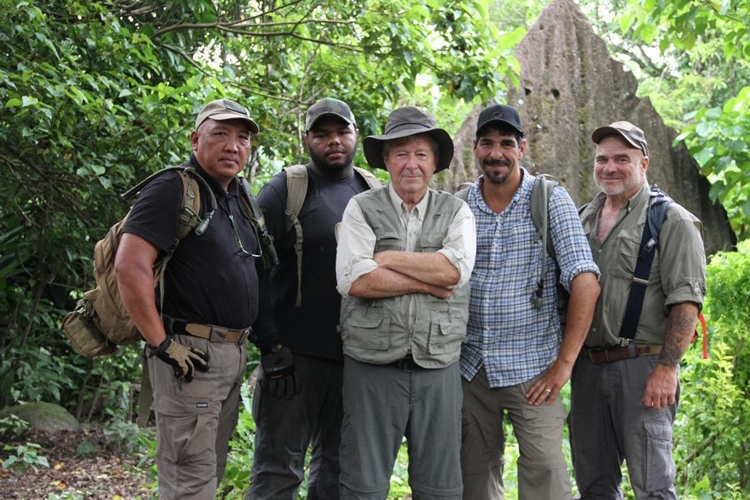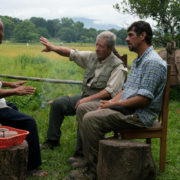
LEGEND has it that during the final months of World War II, Japanese forces constructed underground tunnels in the Philippines to bury treasure worth hundreds of billions of dollars stolen from across Asia.
Often referred to as “Yamashita’s gold” — named after General Tomoyuki Yamashita, who led the Imperial Japanese Army in the Philippines in 1944 — the loot is said to contain gold, jewels, statues and art.
Now 75 years later, despite skeptics throughout the decades, the History Channel is taking viewers along for the adventure as it debuts “Lost Gold of World War II” this Tuesday, March 19 (10 p.m. ET/PT), an eight-part series to uncover one of history’s greatest mysteries.
A Los Angeles-based Filipino man got to take part in the series as a cast member after he responded to a casting call looking for a talent of Filipino-American ancestry who has some knowledge on engineering and investigations.

Manny Paez, founder of shipping company Manila Forwarder, told the Asian Journal that he was semi-retired but was intrigued by the posting because it mentioned the ‘Golden Lily.’
That refers to the secret operation reportedly led by a group of princes to construct and booby-trap, using prisoners of war as labor, the underground tunnels for the treasure.
“When I was a teenager in the Philippines, a lot of people were into treasure hunting and it was an activity I did as a hobby. So when [the post] mentioned Golden Lily, I knew this was something for real because not a lot of people knew about it, so I applied and got called by the casting agent…After many calls, eventually I landed the role,” Paez recalled.
Produced by Ample, with Ari Mark, Phil Lott and Ed Gorsuch as executive producers, the team — composed of investigators and engineers — went to the Philippines in early 2018 to do preliminary shooting for the pilot.
It was picked up by History Channel, which ordered the eight-episode series with Mike Stiller and Mary E. Donahue as the executive producers. The crew went back to the Philippines four times in the last year to finish the season, while some scenes were shot in the United States.
What audiences can expect from these episodes, Mark and Lott, executive producers and co-founders of AMPLE Entertainment, told the Asian Journal in an email, “History isn’t always what it seems. The deeper you go, the stranger it gets.”
In the first episode of “Lost Gold of World War II,” the team meets “Grandpa,” a Filipino farmer who had witnessed the operation during the war and for the first time is sharing his secrets with anyone else.
“We love mystery. When an elderly Filipino rice farmer tells you he saw Japanese troops at the end of World War II, spending months bringing unmarked crates up the mountain in his remote village – you listen,” Mark and Lott said.
The areas in the northern part of the Philippines are not specified in the show, however, because they are still active treasure sites.
Currently, under Philippine laws, those who want to engage in treasure hunting need to secure a permit from the Department of Environment and Natural Resources (DENR).
“There are a lot of things that we found that would give a lot of satisfaction, excitement and knowledge, not only to Filipino Americans, but to all the citizens of the world,” Paez said. “I believe this will promote the Philippines to an international audience because they will see how beautiful the Philippines is and how friendly Filipinos are. This was experienced by most of the crew and the cast.”








Do not expose secret treasures for the Philippines. Please…
This “treasure” is utter nonsense. I wrote a book on the Philippines campaign, Yamashita’s role, and the trial that followed. In all my research, including examination of Yamashita’s message traffic intercepted by the US and his interactions with his lawyers, there was never a mention of any treasure, or any suspicion of a treasure, and Yamashita’s actions, and those of his troops, during this time would have made burial of such a thing utterly impossible. There has never been the slightest evidence of an actual treasure in the 75 years since that time. Shame on the “History” channel for perpetrating this hoax. (The book is Yamashita’s Ghost: War Crimes, MacArthur’s Justice and Command Accountability, University Press of Kansas, 2012).
Allan Ryan your entitled to your opinion but that opinion is WRONG as I have knowledge of people finding gold bars and diamonds FACT not opinion but I’m happy if people like you don’t believe I don’t want thousands of treasure hunters coming here
Pls! pls !Allan Ryan do not believe in Yamashita treasure and can you invite more people not to believe in Yamashita treasure? So the Philippines will not be flooding of treasures hunter .just let me take good care all treasure . I don’t want competitive.
I hope Sir John Casey can help us about our treasure site
Dear Sirs,
I have located what appears to be a buried (dynamited) Japanese limestone cave.
We then discovered a large boulder upon which are carved some very interesting carved treasure symbols relating to this cave.
It is curious that we found the hidden cave before we found these markers telling us where to look for the cave but the markers do indicate that there is a treasure buried underwater inside the cave. (We guessed as much..) This is the meaning of the letter “M”. Just above the letter “M” is the faint outline of a turtle which coincidentally is pointing directly towards the buried cave which is some distance away.
Right beside the letter “M” is a small circle of three tear dropped shaped holes. This we know means “BOMB”.
The big “IX” might be some sort of distance marker but we already know where the cave is and so we are not too concerned about it.
There is at the far left of the stone what appears to be a little Japanese warrior but we have no idea what all the other lines are for.
It would be wonderful if you are in contact with people who might understand such things.
If you are interested, please send me an Email address so I can send a photo of these symbols. Best Regards: – Rick Jackson
dear sir, I found a site of treasure in the mountain boundary of Bataan and olongapo zambalez. I was leave in her barrio cabalan mountain. and I try to hunting the treasure on the mountain. I spent a many years to hunting the treasure of 25 years. on the mountain there’s a lot of a structure of man made stone. like triangle stone on the top of the hill, circle stone, marker, cave,and other sign that have a treasure. and according to my knowledge. this site or this mountain is called place of treasure. according to the sign and symbol code of masako code book. the mountain is sign of salakot mountain place of treasure. there’s a lot of sign and symbol marker, like a trunk a hundred years old a very tough it’s look like a steel.there is a while in 20 feet .riprap on the slope, big stone.is scattered. and there was a sign say the treasure is scattered.
Mr. Peter Struzzeri,
I can contribute a lot, just email me.
Hello Everyone,
My name is Bernard and currently reside outside Phil’s. From Aug 2018 to June 2019 I was doing treasure. There was 1 project that I spent 6 months which I believe a treasure site because of the markers we discovered like triangle shape, twin heart carve in the stone, logs, bottles, drums and many others. We are force to stop the project last June because of the rainy season. The group will resume the operation sometime November this year. I am looking for expert to help us locate and identify the treasure. Anyone who has great skills and knowledge of Japanese treasure kindly email me (bernard.felix30@gmail.com). Once, we establish the relationship and trust I am more than willing to share photos for you to look at.
Hi Peter and John and the History Channel, kindly contact me for a huge information and location of what you are doing and looking for here in the Philippines. My story is highly classified but I’m available if you are interested to meet me in person. XXX +639562568700